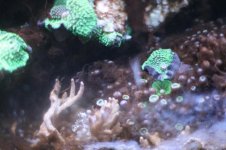Hi,
For the past 2-3 months I had an increasingly nasty cyano problem. At
least I think that it's a cyano problem (please see the pics): it's a
film that I can suck up with an air-tube and it makes bubbles until it
starts floating. It's not like the cyano I got in the beginning, but I
think that it's cyano anyway.
A bit of background: system is 4 years old, 90 gals display + 20 gals
upstream fuge + 75 gals sump. Nothing significant happened until 2-3
months ago except for a drop in Ca and Alk (then an over-correction on
Alk that lead to a storm, but by that time the cyano was already in
full swing).
From what I know cyano problems are due to:
- phosphates
- low oxygen
- low flow
The phosphate test came negative (as zero as it gets), for oxigen -
it's hard to believe: I have an euro-reef skimmer (RS100 I think)
running 24/7, the return from my fuge fills my display with bubbles
and the drop from my display fills my sump with bubbles. There should
be *plenty* of oxygen in there. Also I have the sump running on
reverse cycle and I have chaeto in the sump.
Other things I tried: increase Ca and Alk - at some point I got the
storm, now it's back to normal, tested for nitrates - zero, changed
bulbs both in the fuge and the tank, sucked the cyano and threw away -
nothing helped. Actually after sucking the cyano, it seems to come
back worse than before (at least sometimes).
My fuge that has lower flow than the display does get more cyano than
the display, but I have significant quantities of cyano right under
where a MaxiJet 1200 is hitting the glass of the tank. Also, all over
the glass (both front and back).
It also seems that later in the day (towards the end of the cycle) the
cyano is slightly backing off..
It clearly bothers the corals, smothering some. It killed one colony
and now it's decimating the Xenia, Anthelia and some Briareum (even
the GSPs are affected). I'm assuming that this slaughter is what is
currently fueling it (the skimmer is foaming out of the cup). Any
ideas on how to stop this slow-moving tank crash?
I know about the antibiotics, but if I can help it in any way I'd rather remove the cause rather than the effect...
Any ideas are welcome!
Thanks!
Mihai
BTW, in case that PLB reads this, yes I have a large clump of
Chaetomorpha in the fuge but it's not growing at all - I assume it has
to do with the lack of nitrates and phosphates. Maybe...
For the past 2-3 months I had an increasingly nasty cyano problem. At
least I think that it's a cyano problem (please see the pics): it's a
film that I can suck up with an air-tube and it makes bubbles until it
starts floating. It's not like the cyano I got in the beginning, but I
think that it's cyano anyway.
A bit of background: system is 4 years old, 90 gals display + 20 gals
upstream fuge + 75 gals sump. Nothing significant happened until 2-3
months ago except for a drop in Ca and Alk (then an over-correction on
Alk that lead to a storm, but by that time the cyano was already in
full swing).
From what I know cyano problems are due to:
- phosphates
- low oxygen
- low flow
The phosphate test came negative (as zero as it gets), for oxigen -
it's hard to believe: I have an euro-reef skimmer (RS100 I think)
running 24/7, the return from my fuge fills my display with bubbles
and the drop from my display fills my sump with bubbles. There should
be *plenty* of oxygen in there. Also I have the sump running on
reverse cycle and I have chaeto in the sump.
Other things I tried: increase Ca and Alk - at some point I got the
storm, now it's back to normal, tested for nitrates - zero, changed
bulbs both in the fuge and the tank, sucked the cyano and threw away -
nothing helped. Actually after sucking the cyano, it seems to come
back worse than before (at least sometimes).
My fuge that has lower flow than the display does get more cyano than
the display, but I have significant quantities of cyano right under
where a MaxiJet 1200 is hitting the glass of the tank. Also, all over
the glass (both front and back).
It also seems that later in the day (towards the end of the cycle) the
cyano is slightly backing off..
It clearly bothers the corals, smothering some. It killed one colony
and now it's decimating the Xenia, Anthelia and some Briareum (even
the GSPs are affected). I'm assuming that this slaughter is what is
currently fueling it (the skimmer is foaming out of the cup). Any
ideas on how to stop this slow-moving tank crash?
I know about the antibiotics, but if I can help it in any way I'd rather remove the cause rather than the effect...
Any ideas are welcome!
Thanks!
Mihai
BTW, in case that PLB reads this, yes I have a large clump of
Chaetomorpha in the fuge but it's not growing at all - I assume it has
to do with the lack of nitrates and phosphates. Maybe...








